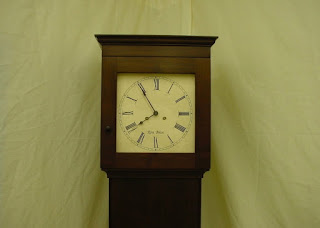I've made two clocks that reside in our house and several others that reside in other people's homes. When woodworkers visit my home they always ask where I sourced the dials with the custom typesetting. On my clocks it's my name as the maker in the lower section of the dial.
Years ago when I was a full time furniture maker I was asked to display my work in conjunction with a local painter at the local Upson Arts Council Gallery. I was flattered but I was a commissioned furniture maker and everything I had made up to that point was bespoke. Where would I get pieces to exhibit? Fortunately some of my customers offered to let me display their pieces and with a couple of new pieces I would have a nice presence in this event.
One of the new pieces I chose to make was my version of the Watervliet, tall case Shaker clock. I had been told when you make a speculative piece you should make something you would like to have because you just might end up with it.
Julie and I were in the process of designing our house and the clock was something that appealed to both of us. We designed a place for such a clock right between two windows in what was to be the parlor of the new house.
Long story short, the clock did not sell at the gallery event but did sell subsequent to the event and my lovely spouse was not pleased that the clock she thought would be gracing the parlor of her new home sold. Fortunately I made a duplicate clock 5 years later.
To make the clock I had to obtain the clock movement and dial. I actually purchased a metal dial that was a reproduction of a Shaker Wall clock dial including the date 1840. When I received the dial a couple things were wrong. (1) The outer edge of the dial was terribly out of square and putting that dial in a clock that I was making with the date 1840 on the face was just an absurd idea. So I searched for another alternative.
At that time there was a gentleman in Marietta, GA. named Larry Petro. He had a business called Old Tyme Clocks. He also had an online business where he marketed his paper clock dials. He printed these dials on very nice heavy card stock and offered custom type setting in two locations on the clock face. It was exactly what I was looking for and in subsequent years I ordered several clock dials from Larry.
I've made 2 clocks in the last couple years and unfortunately my source for custom clock dials is no longer in existence. I set about making my own faces for my clocks. This was quite a time consuming process but it was the only way to obtain a clock dial with custom text. Lately it's occurred to me that there are probably many people making clocks that would like to have custom dial faces for their clock project. Just recently I've decided to offer clock dials with custom typesetting on the face.
I'll begin this pursuit by offering the clock dial that is probably used more than any other. This style dial looks very nice in a Shaker clock case but is also very appropriate for many other style clocks. I will offer this dial in 5 sizes that also coordinate in size with easily available clock hand sizes.
The most common added text is the makers name in the lower dial position, however if you have a "brand" you might want to add that text in the top position as shown above.
The dial sizes are based on the diameter of the time ring and I will offer 5", 6", 7", 8" and 9" time ring diameter dials. The dials are printed on 12 x 18 heavy parchment card stock that will stand up to gluing and could serve as a pallet for an artist to hand paint these to a more elaborate design. If a different size time ring is desired, contact me, I may be able to accommodate your request.
I'm offering the dials in 3 different variations of the parchment color. "White Parchment", "Natural Parchment" and what I'm guessing will be the most popular color "Aged Parchment".
 |
White parchment
|
 |
Natural Parchment
|
 |
| Aged Parchment |
Also the text can be done in any of the 7 fonts shown below.
The base dial will be $33.00. For any dial with custom text in the Lower or Upper position, there will be a $14.00 add on. This cost will cover 2 lines of text in either position or both. Shipping will be $12.00 anywhere in the lower 48 states and international shipping will be actual shipping cost. Duplicate dials are available for an additional $18.00 each.
For instance if you order a dial with custom text the total would be $47.00 plus Shipping. An additional duplicate of that dial made and shipped together would only be an additional $18.00 with no additional shipping cost. (note the duplicate can be on different colored card stock)
The duplicate dial pricing will create some economy for people making multiple clocks. So if you're making clocks as gifts for all the kids this Christmas ordering the dials together could certainly reduce your overall cost.
See buy buttons at the bottom of the page. At this time you can only order the clock dials from this blog post, but soon there will also be a clock dial page on the Brese Plane web site,
www.breseplane.com
I realize there are a lot of variable options for the clock dials so if you want to order clock dials but are unsure of how to order just send me an email and we'll sort out your particular needs.
ronbrese@breseplane.com
CLOCK DIALS are NO LONGER AVAILABLE
If you are still unsure if you ordered your dial/dials correctly don't despair, I will contact you via email to verify the details of your order prior to printing.
The kid pictured above is August Brese Paglia, more commonly known as "Gus". At the particular moment this picture was taken he had claimed reign over the climbing rock at Greenwood playground in Brooklyn, NY. The shoes he was sporting are called his "Crock Flops" which I thought was a hilariously original name for his shoes. My Grandchildren crack me up!






















































